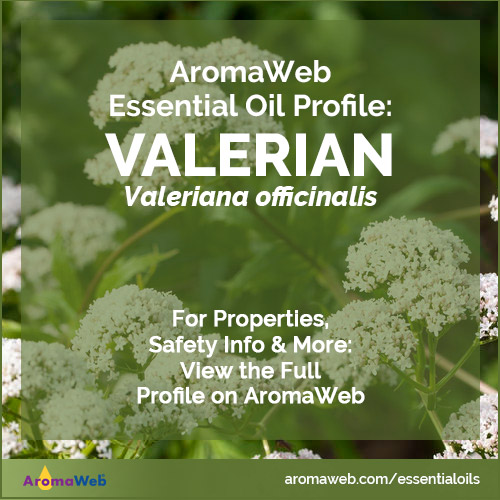Valerian Essential Oil
Valeriana officinalis

Description
Valerian Essential Oil is steam distilled from the roots of Valeriana officinalis. This pretty plant produces pretty pinkish white flowers, but it's the roots that are responsible for the extraordinarily relaxing properties that valerian is known for.
Valerian Essential Oil is primarily used to help aid instances of insomnia, restlessness and nervous tension.
Valerian Oil is abundant in sesquiterpenes and sesquiterpenols. The composition of Valerian Oil can vary dramatically based on country of origin and growing conditions.
The aroma of Valerian Oil can be pungent and unpleasant, depending on the distillation, origin of the oil and the age of the oil. If you find the aroma to be hard to tolerate, the aroma can be softened dramatically by blending it at low dilution with other essential oils. I find that Valerian Essential Oil tends to blend well aromatically with Lavender, Roman Chamomile, Vetiver, Patchouli and Sweet Orange.
Valerian Essential Oil Benefits and Uses
- Insomnia
- Nervous Tension
- Migraine
- Nervous Indigestion
References: Salvatore Battaglia, The Complete Guide to Aromatherapy (Australia: The Perfect Potion, 2003), 582.
Botanical Name
Plant Family
Common Method of Extraction
Steam Distilled
Plant Part Typically Used
Color
Yellowish-green to greenish-brown.
Consistency
Thin
Perfumery Note
Base
Strength of Initial Aroma
Strong
Aromatic Description
Valerian Essential Oil smells tenacious with warm, woody, balsamic characteristics. Depending on the age of the oil and the distillation, some Valerian Oils can smell more unpleasant than others and have an aromatic quality that resembles smelly feet. [Reference: Steffen Arctander, Perfume and Flavor Materials of Natural Origin (Reprint Edition. Elizabeth, NJ: Pathfinder., 2017), 637.]
Major Constituents
- Valerianol
- Bornyl acetate
- Valeranone
- Valeranal
- Camphene
- a-Kessyl acetate
- Elemol
See Essential Oil Safety for a more complete list of typical constituents.
Reference: B.M. Lawrence, Progress in Essential Oils, Number 3. (Perfumer & Flavorist 24, 1999), 53-56. Source cited in Robert Tisserand and Rodney Young, Essential Oil Safety (Second Edition. United Kingdom: Churchill Livingstone Elsevier, 2014), 461.
Valerian Essential Oil Safety Information
Tisserand and Young do not indicate any special precautions when using Valerian Essential Oil. Reading Tisserand and Young's full profile is recommended. [Robert Tisserand and Rodney Young, Essential Oil Safety (Second Edition. United Kingdom: Churchill Livingstone Elsevier, 2014), 461-462.]
As mentioned by Salvatore Battaglia: "Pizzorno & Murray state that there is some concern that valerian may prolong thiopental and pentobarbital-induced sleep. This indicates the need to avoid concurrent use of valerian and barbituates." [Reference: JE Pizzorno and MT Murry. Textbook of natural medicine, 4th edition. Churchill Livingston, 2013 as cited in Salvatore Battaglia, The Complete Guide to Aromatherapy (Australia: The Perfect Potion, 2003), 582.]
General Safety Information
Do not take any oils internally and do not apply undiluted essential oils, absolutes, CO2s or other concentrated essences onto the skin without advanced essential oil knowledge or consultation from a qualified aromatherapy practitioner. For general dilution information, read AromaWeb's Guide to Diluting Essential Oils. If you are pregnant, epileptic, have liver damage, have cancer, or have any other medical problem, use oils only under the proper guidance of a qualified aromatherapy practitioner. Use extreme caution when using oils with children and be sure to first read the recommended dilution ratios for children. Consult a qualified aromatherapy practitioner before using oils with children, the elderly, if you have medical issues or are taking medications. Before using this or any essential oil, carefully read AromaWeb's Essential Oil Safety Information page. For in-depth information on oil safety issues, read Essential Oil Safety by Robert Tisserand and Rodney Young.
Shelf Life
Important Information About the Profiles
The essential oil information provided on AromaWeb is intended for basic educational purposes only. The references to safety information, test results, constituents and percentages is generalized information. Essential oils can vary greatly in composition. The data is not necessary complete and is not guaranteed to be accurate. The essential oil photos are intended to represent the typical and approximate color of each essential oil. However, essential oil composition and color can vary based on harvesting, distillation, age of the essential oil and other factors. Profiles for several CO2 Extracts and absolutes are included within the directory, and are denoted as such.
